
The spoonhead sculpin is a species of freshwater ray-finned fish belonging to the family Cottidae, the typical sculpins. This species is widespread in northeastern North America.

The slimy sculpin is a freshwater species of fish belonging to the family Cottidae, which is the largest sculpin family. They usually inhabit cold rocky streams or lakes across North America, ranging from the Great Lakes, southeast Minnesota, northeast Iowa, southwest Wisconsin and northeast Canada. Slimy sculpins have also been found roaming the cold streams of eastern Siberia. They are commonly confused with their closely related relatives, Mottled sculpin, and with tubenose gobies who are both freshwater fishes as well. The slimy sculpin is a nocturnal fish that usually spends most of its time on the stream bottom and seeks shelter under rocks and logs, especially during spawning season. When it swims, it sometimes appears to be "hopping" along the bottom because of its inefficient ability to swim. This is partly due to the absence of a swim bladder, which normally gives buoyancy to a fish.

Cottus is a genus of the mainly freshwater ray-finned fishes belonging to the family Cottidae, the typical sculpins. They are often referred to as the "freshwater sculpins", as they are the principal genus of sculpins to be found in fresh water. They are native to the Palearctic and Nearctic.

The European bullhead is a freshwater fish that is widely distributed in Europe, mainly in rivers. It is a member of the family Cottidae, a type of sculpin. It is also known as the miller's thumb, freshwater sculpin, common bullhead, and cob.
The Shoshone sculpin is a species of freshwater ray-finned fish belonging to the family Cottidae, the typical sculpins. It is It is endemic to the United States. It inhabits spring systems in the Thousand Springs formation near Hagerman, south-central Idaho. It reaches a maximum length of 9.0 cm. The specific name honors Charles Wilson Greene who was an instructor in physiology at Stanford University and was on the expedition on which the type was collected from the Thousand Springs on the Snake River, near mouth of Salmon Falls River in Gooding County, Idaho.

The Wood River sculpin is a species of freshwater ray-finned fish belonging to the family Cottidae, the typical sculpins. It is endemic to the Big Wood and Little Wood rivers and their tributaries upstream of Magic Reservoir in Blaine County, Idaho in the United States. Its habitat is similar to other sculpins: small to medium-sized streams that are cool and have swift currents. It is a species of concern because of its restricted distribution.

The Klamath Lake sculpin is a species of freshwater ray-finned fish belonging to the family Cottidae, the typical sculpins. It is endemic to the Agency and Upper Klamath Lakes in Oregon, USA. It reaches a maximum length of 7.0 cm. It prefers rocky and sandy shores of the lakes.
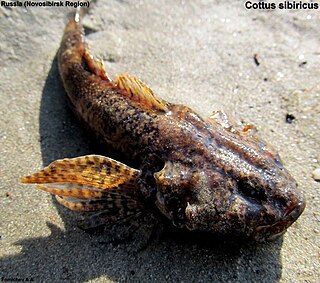
The Siberian sculpin is a species of freshwater ray-finned fish belonging to the family Cottidae, the typical sculpins.. It is found in Siberian river basins of the Arctic Ocean from the Ob to Yana rivers. It reaches a maximum length of 15.0 cm
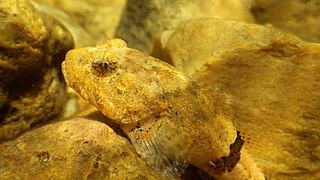
The banded sculpin is a freshwater fish dwelling mostly in small to moderate sized streams in areas of swift current. Young and juvenile C. carolinae can mainly be found in pools, riffles, and other shallow habitats while adults tend to prefer deeper waters. C. carolinae primarily eats insects and insect larvae, but their large mouths enable them to eat prey nearly as large as themselves, including other sculpin. To prevent predation, including by other fish, the color and pattern of the sculpin tends to match its environment. Most Cottus carolinae are mottled brown with dark vertical banding and usually reach about three inches in length. They have a broad head which rather quickly narrows into a slim body, giving them the appearance of a tadpole reaching adulthood.
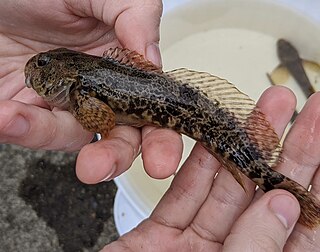
The prickly sculpin is a species of ray-finned fish belonging to the family Cottidae, the typical sculpins. It is native to the river drainages of the Pacific Slope of North America from Seward, Alaska south to the Ventura River of Southern California. It extends east of the Continental Divide in the Peace River of British Columbia. It has also been introduced to several reservoirs in Southern California.
The Sakhalin sculpin is a species of amphidromous ray-finned fish belonging to the family Cottidae, the typical sculpins. It is found in eastern Russia to northern Japan. It reaches a maximum length of 20.8 cm. The Sakhalin sculpin was first formally described in 1904 by the Russian zoologist Peter Yulievich Schmidt with its type locality given as the Lyutoga River on Sakhalin. This species is sometimes placed in the subgenus Cephalocottus. The specific name is a misspelling of Ambystoma, the axolotl combined with opsis, meanning "having the look of", and Schmidt described it as having a head that is “strongly dorsoventrally depressed, wide, nearly flat dorsally, abruptly sloping laterally, similar to the head of an axolotl” (translation).
The shorthead sculpin is a species of fish in the family Cottidae. Shorthead Sculpins are bottom-dwelling small fish, typically sizing around 13 to 15 cm long. They have large heads and fanlike pectoral fins. They have 7-9 dorsal spines, 15-19 dorsal soft rays, and 10-14 anal soft rays. Narrow caudal peduncle. Palatine teeth and coloration being dark brown and yellow.

Cottus duranii, the Dordogne sculpin or Chabot d’Auvergne, is a species of freshwater ray-finned fish belonging to the family Cottidae, the typical sculpins. It is found in France. It inhabits the Loire and Dordogne river drainages. It reaches a maximum length of 10.0 cm. It prefers streams with clear, cool, moderate to swift water and stone substrate. This species was described as a separate species from the European bullhead in 2005 by Jörg Freyhof, Maurice Kottelat and Arne W. Nolte. The specific name durani means “of Duranius”, the Latin name of the River Dordogne.
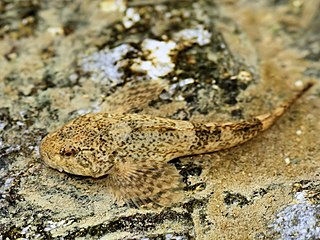
Cottus rhenanus is a species of freshwater ray-finned fish belonging to the family Cottidae, the typical sculpins. It is found in France, Belgium, Germany, Luxembourg, and the Netherlands. It inhabits the Rhine and Meuse river drainages. It reaches a maximum length of 10.0 cm. It prefers streams with clear, cool, moderate to swift water and stone substrate. Here, it mostly occurs in the shallow parts of streams. This species was described as a separate species from the European bullhead in 2005 by Jörg Freyhof, Maurice Kottelat and Arne W. Nolte. The specific name rhenatus means belonging to Rhenus, the Latin name of the River Rhine.
The Columbia sculpin is a species of fish in the family Cottidae. It is found in the United States and Canada, inhabiting the Columbia River drainage and Harney Basin in Oregon, British Columbia, Idaho, Washington, and Nevada. It reaches a maximum length of 11.2 cm. It prefers rocky riffles of headwaters and creeks.
The Ozark sculpin is a species of ray-finned fish belonging to the family Cottidae, the typical sculpins. It is endemic to Missouri,United States. Inhabiting the Osage, Gasconade, and Black river drainages in Missouri. It reaches a maximum length of 14.0 cm. It prefers rocky riffles of headwaters and creeks.
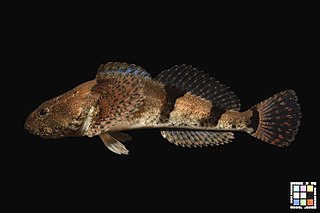
The fourspine sculpin is a species of freshwater ray-finned fish belonging to the family Cottidae, the typical sculpins. It is endemic to Japan. It reaches a maximum length of 30.0 cm (11.8 in).

Cottus nozawae is a species of freshwater ray-finned fish belonging to the family Cottidae, the typical sculpins. It is found in southern Sakhalin Island in Russia, Hokkaido and northern Honshu in Japan and in the Korean Peninsula. It reaches a maximum length of 6.9 cm. This species was first formally described in 1911 by the American ichthyologist John Otterbein Snyder with its type locality given as the Ishikari River at Sapporo on Hokkaido. This species is sometimes placed in the subgenus Cephalocottus. The specific name honours zoologist Shunjiro Nozawa, Director of the Fisheries Bureau on Hokkaido.

The reticulate sculpin is a species of freshwater ray-finned fish belonging to the family Cottidae, the typical sculpins. It is found in the United States, inhabiting Pacific Slope drainages from the Snohomish River and Puget Sound in Washington to the Rogue River system in Oregon and California. It reaches a maximum length of 10.0 cm. This sculpin occurs in a variety of habitats, but mainly occurs in the slower sections of coastal headwaters, creeks, and small rivers. It prefers faster water with rubble or gravel substrate, but occurs in pools and along stream edges when other sculpin species are present. Often it occurs in clear cold water in forested areas. Its ideal habitat is cold creeks in old-growth forest, with plenty of riffles and runs. This species is tolerant of variable water temperatures and salinities. Where other sculpin species are common, spawning occurs in slow-flowing areas; where other sculpin species are rare or absent, spawning usually occurs in riffles.
The Pit sculpin is a species of freshwater ray-finned fish belonging to the family Cottidae, the typical sculpins. It is found in the United States, inhabiting the Pit and upper Sacramento River systems in Oregon and California. It reaches a maximum length of 13.0 cm. It prefers rubble and gravel riffles.













